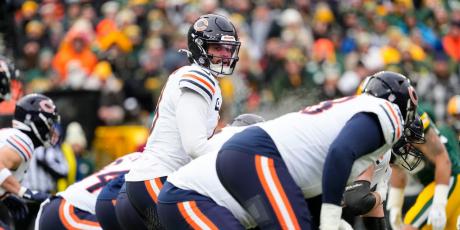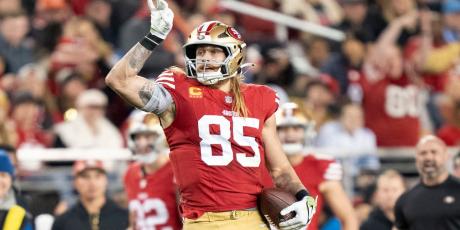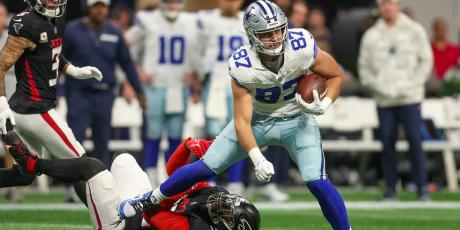Game Script Sensitivity and an Intro To Win-Adjusted Rush Rates

NFL play callers can be a tough nut to crack, especially when it comes to fantasy football analysis. While coaches tend to have general philosophies about how to call a game, oftentimes player talent and a team’s overall success can disrupt a play caller’s intentions and distort pass/run splits. In general, teams that are winning will run more and teams that are losing will throw to try to catch up, but the degree to which this takes place varies from coach to coach.
By looking at pass/run splits in wins and losses, instead of end-of-season totals, this study hopes to quantify how sensitive each play caller is to game script and how wins and losses might impact end of season splits.
Play Calling and Game Script Sensitivity
The following table illustrates how sensitive each active play caller has been to game script, by listing the percentage increase in run plays called when that coach wins versus when he loses.
| Play Caller | 2015 Rush % in Wins vs. Losses | Career Rush % in Wins vs. Losses |
|---|---|---|
| Hue Jackson | +12.2% | +17.1% |
| Norv Turner | +23.4% | +16.8% |
| Mike Mularkey | N/A | +16.5% |
| Chan Gailey | +14.4% | +16.1% |
| Greg Roman | +19.0% | +15.3% |
| Chip Kelly | +14.8% | +15.0% |
| Rob Chudzinski | N/A | +14.2% |
| Dirk Koetter | +16.1% | +13.5% |
| Gary Kubiak | +13.5% | +13.4% |
| Ken Whisenhunt | N/A | +13.1% |
| Greg Olson | +12.5% | +12.3% |
| Bruce Arians | +19.4% | +12.3% |
| Bill O'Brien | +17.2% | +12.2% |
| League Average | +12.2% | |
| Bill Musgrave | +6.9% | +11.9% |
| Jay Gruden | +11.3% | +11.8% |
| Sean Payton | +9.0% | +11.5% |
| Mike Shula | +11.7% | +11.1% |
| Andy Reid | +14.3% | +10.9% |
| Todd Haley | +5.0% | +10.8% |
| Mike McCarthy | +12.8% | +10.7% |
| Darrell Bevell | +11.2% | +10.6% |
| Ben McAdoo | +8.4% | +10.1% |
| Josh McDaniels | +1.7% | +10.0% |
| Kyle Shanahan | +12.8% | +9.7% |
| Adam Gase | +1.3% | +9.4% |
| Marc Trestman | +1.3% | +8.9% |
| Scott Linehan | +12.6% | +8.1% |
*N/A denotes coaches without a full season of data
This graphic shows that Hue Jackson has been the most game script dependent coach when it comes to calling plays. On average, Jackson’s teams run 17 percent more in games that they win compared to games that they lose.
On the other end of the spectrum is Scott Linehan, who runs just eight percent more when his team is winning. In other words, Linehan is very likely to stick to his game plan, regardless of the results, while a coach like Jackson tends to adjust to the situation.
Introduction to Win-Adjusted Rush Rate
We’ve already shown that play callers will vary in terms of how much they change their pass/run splits in wins and losses, but that doesn’t tell the entire story. We also have to examine how often coaches are winning or losing to get an idea of their true play-calling tendencies in the first place.
In order to compare play callers in an apples-to-apple manner, we can adjust their pass/run splits for wins and losses. Rather than comparing a team's end of season run rate to the league average, we can look at how often a team runs in wins and losses and compare those averages to league average rush rates in wins and losses. A weighted average (weighted by the number of wins and losses) of those differentials will give a more accurate representation of how much a team runs compared to expectation, regardless of game script and whether or not they were successful in the win column.
Consider the 2015 Carolina Panthers. Carolina ran the ball on 49.6 percent of their plays, second most in the league, and 8.7 percentage points above the league average. The Panthers won 15 games, though, running the ball on 50.1 percent of plays in those wins. Across the entire league, teams ran the ball on 47 percent of plays in wins, so for most of the season, Carolina was running the ball just three percentage points over expectation. Their end-of-season run rate is inflated because they won so many games, and anyone that looks at Mike Shula’s pass/run splits from 2015 might have a slightly distorted perception of how Shula likes to call plays:
| Number of Wins | Rush % in Wins vs League AVG | Rush % in Losses vs League AVG | Weighted AVG | League AVG Rush % | aRush% |
|---|---|---|---|---|---|
| 15 | +3.2% | +3.7% | +3.2% | 40.9% | 44.1% |
Adjusted for wins, the Panthers ran just 3.2 percent more than expected, giving them a Win-Adjusted Rush Rate (aRush%) of 44.1 percent (3.2 percent over the league average rush rate of 40.9 percent), making Carolina the eighth-most run-heavy team in 2015, when adjusted for wins.
Here’s a look at the aRush% for all 32 teams in 2015 compared to their actual run rate:
| Team | Wins | Rush % | Rush % in Wins | Rush % in Losses | aRush% |
|---|---|---|---|---|---|
| Bills | 8 | 50.1% | 60.2% | 41.2% | 50.8% |
| Rams | 7 | 46.6% | 55.8% | 40.2% | 47.9% |
| Bears | 6 | 45.7% | 46.5% | 45.2% | 47.2% |
| Seahawks | 10 | 48.3% | 52.3% | 41.1% | 46.7% |
| Vikings | 11 | 48.7% | 55.8% | 32.4% | 46.3% |
| Buccaneers | 6 | 44.7% | 54.7% | 38.6% | 46.2% |
| Cowboys | 4 | 42.1% | 45.4% | 40.8% | 45.1% |
| Panthers | 15 | 49.6% | 50.1% | 38.5% | 44.1% |
| Bengals | 12 | 46.5% | 49.7% | 37.5% | 43.6% |
| Chiefs | 11 | 45.7% | 50.3% | 36.0% | 43.6% |
| 49ers | 5 | 40.2% | 49.1% | 35.9% | 42.3% |
| Titans | 3 | 38.0% | 51.6% | 34.8% | 41.9% |
| Redskins | 9 | 42.4% | 47.1% | 35.9% | 41.5% |
| Texans | 9 | 41.9% | 49.5% | 32.3% | 41.3% |
| Eagles | 7 | 40.2% | 48.4% | 33.6% | 40.9% |
| Browns | 3 | 36.5% | 47.8% | 33.8% | 40.3% |
| Jets | 10 | 41.7% | 47.0% | 32.6% | 40.1% |
| Packers | 10 | 41.3% | 46.3% | 33.5% | 40.0% |
| Giants | 6 | 38.3% | 43.6% | 35.2% | 39.9% |
| Cardinals | 13 | 43.4% | 47.0% | 27.7% | 39.7% |
| Falcons | 8 | 39.2% | 45.5% | 32.6% | 39.1% |
| Chargers | 4 | 35.7% | 40.9% | 34.0% | 38.8% |
| Colts | 8 | 37.6% | 43.0% | 32.3% | 37.7% |
| Ravens | 5 | 35.4% | 42.2% | 32.2% | 37.6% |
| Raiders | 7 | 36.7% | 40.6% | 33.7% | 37.5% |
| Jaguars | 5 | 35.0% | 43.6% | 31.0% | 37.3% |
| Steelers | 10 | 38.4% | 40.3% | 35.2% | 36.9% |
| Dolphins | 6 | 35.2% | 47.2% | 28.1% | 36.9% |
| Saints | 7 | 36.2% | 41.0% | 32.0% | 36.7% |
| Broncos | 12 | 38.9% | 42.3% | 28.8% | 35.9% |
| Lions | 7 | 34.4% | 41.3% | 28.7% | 35.0% |
| Patriots | 12 | 36.5% | 36.9% | 35.2% | 33.5% |
Notes about Game Script Sensitivity and aRush%
- Coaches that are more run-heavy tend to be more game script sensitive.
- In 2015, the average rush rate was 47 percent in wins and 34.8 percent in losses.
- Not all teams that rush more than average in wins are also more run-heavy than usual in losses. Of the 15 teams that ran more than average in wins in 2015, eight of those teams threw the ball more than average in losses.
- Teams that throw more than average in wins, usually throw more than average in losses as well.
- Teams that win more will rank lower in aRush%, but to what degree depends on the play caller.
- aRush% carries over much more from one year to the next than actual rush rate. While the year-to-year correlation for rush rate is just .38, for aRush% the correlation is .50.
Applying Game Script Sensitivity and aRush% to Your Fantasy Football Research
Going into a new season, coaches are often scrutinized for their play-calling tendencies, but many times pass/run splits aren’t a true reflection of a coach's intentions. Win-Adjusted Rush Rate hopes to quantify how often coaches are likely to run the ball in a neutral situation.
Given this information, fantasy football owners can project pass/run splits by determining if a play caller is truly run-heavy or pass-heavy and then gauging that coach’s level of sensitivity to game script. As with any statistic, the more data that we have, the more accurate our info is likely to be.
Because this data has the potential to be especially disruptive to narratives surrounding current play callers, all of my coaching studies moving forward will reference aRush% when discussing a coaches pass/run splits.
Editor's Note: Early bird rates end June 30th for 4for4's Premium and DFS Subscriptions.






















